SHAPE America’s 50 Million Strong by 2029 commitment has a very clear vision: To get all of America’s school-aged youth physically active and healthy by the year 2029. Less clear, is how America’s physical and health educators can successfully accomplish such a challenging mission. But what many teachers have recognized is that a workable approach is to accept that “it starts with me.” While individual teachers don’t control what happens outside of their school, they do control what they choose to do and choose not to do with their own students. What follows is a description of how one teacher is attempting to change the way that his students think about and approach physical activity.
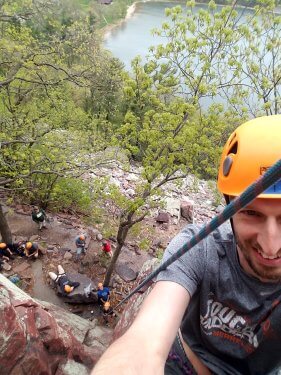
Not long ago, Peter Toutenhoofd – Mr. T. as he is known to his students – a physical educator from South High, Sheboygan, WI received a PEP Grant. He asked himself, “How might my students best benefit from this funding?” Mr. T decided to take a non-traditional approach and to create an Adventure Education program. Here’s what he did:
Students were first given a formal definition of Adventure Education and then asked to rewrite it into their own words. This process allowed Mr. T to check for understanding and ensure teacher and students were thinking similarly. Next a “Full Value Contract” (FVC) involving PEEP (physical, emotional, environment, and personal elements) was explained and students were challenged to design one they could all agree to for the class. Once this FVC was written and modified, all participants were required to sign it. Some of the key elements in the contract included the following:
- Agree to create and participate in a group that is physically and emotionally safe.
- Agree to work together to achieve individual and group (class) goals.
- Agree to give and receive feedback pre- and post-activity.
- Agree to no ‘put downs’ towards self or others.
- Agree to ‘let go’ of negatives and ‘move on’ in a growth process.
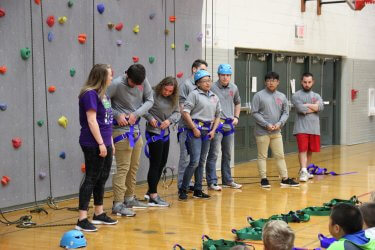
The preliminary course content included learning about the need to understand and participate in the following sequential ‘Stages of Adventure’:
- Acquaintance Activities
- Warm ups/Deinhibitizers
- Communication
- Problem Solving
- Trust
- Low Elements
- High Elements
- Processing Experiences
- Application to Real Life
Class instruction also involved the application of Kolb’s cycle of experimental learning using concrete experiences, reflective observation, abstract conceptualization, and active experimentation during the semester.
Students were involved in activities that promoted learning through physical activity by means of involvement rather than mere ‘telling’ or ‘showing’ concepts. The class covered all nine ‘stages of adventure’ including the culminating high-wall climb after previously experiencing the paradigm involving risk and allowing for self-discovery in achieving peak experiences. Prior to the climb, course content exposed students to the principles of ‘Misadventure’ and ‘Devastation’ with an emphasis upon safety during all activities. As the semester progressed, ‘challenge by choice’ was offered allowing for often needed individual activity modifications (PEEP).
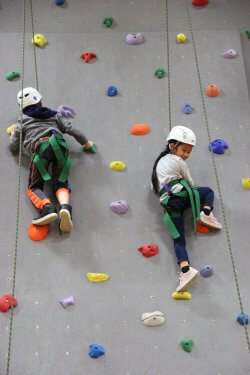
Through participation in this class, students experienced a variety of activities that allowed them to be put into unique settings often outside personal comfort zones. Physical activities were used to overcome challenges while working cooperatively toward a successful solution. But then, upon completion of their personal experiences for the Adventure Education class, students took on one last challenge – to become the teachers for others! The students were asked to use their newly acquired knowledge to construct an Adventure Experience for both members of the greater Sheboygan community and for two area grade school PE classes.
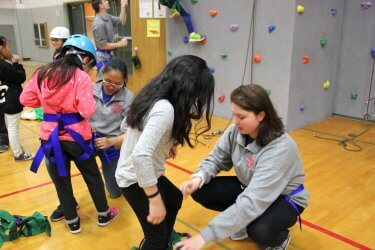
Mr. T’s high schoolers readily accepted this challenge and worked cooperatively as they had done all semester to design a mini-adventure experience that culminated in a wall climb to be used as a partial fundraiser to help sustain the school’s wall and equipment. They used their training and learning experience to conduct an evening open community climb event (for which participants were charged a nominal fee). This not only helped to generate funds but served to spark community interest in Adventure Education – in particular the use of the climbing wall. This initial event was attended by approximately 75 community members and was deemed successful by all involved. Plans are in process for more community wall climbs.
A month later, class members ventured into the wilderness of a popular Wisconsin Dells camping & hiking area (Devils Lake), for a field trip that gave them opportunities to utilize the skills and techniques learned during the semester. These real-life experiences proved to be challenging, rewarding and fun for all participants.
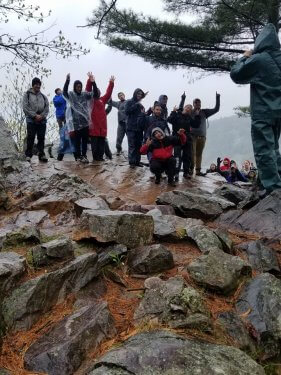
Following this event, Mr. T’s students also conducted two half-day Adventure Education experiences for Jackson and Jefferson Elementary children in coordination with Sheboygan District PE staff, Kevin Herber and Dave Rautmann.
Reaction to the class and all accompanying events was positive and served to promote a path leading toward the development of 50 Million Strong by 2029. Here are some selected comments from those involved:
- “We were thrilled to be involved in this event. I was very impressed with the engagement of the high-school students working with participants and with the younger kids. We thought we might stay for 30-minutes and ended up leaving 2 hours later – a safe and fun event for all! It was enjoyable seeing a 5-year old climbing next to a 10-year old. What a positive way to expose children and families to an activity that promotes healthy life pursuits!” (Amanda Rammer, a parent whose family engaged in the community wall climb)
- “I originally took the class because I needed a gym class and Mr. T. was offering the field trip as part of it. It was so much fun, I almost forgot we were actually learning stuff – how to work together, problem solving, and developing relationships between us. It kind of made me feel like a kid again whose only purpose is to have fun.” (Journal entry from one of the high school class students)
- “It is nice to have a PE class that offers skills and teamwork, allows students to have authentic real-life experiences, and then be able to implement that learning by ‘giving back’ to others.” (South Principal, Kevin Formolo)
- “I’m excited to see how far my students have come using these experiences to connect to real life. Despite the rainy weather for our Dells trip, that part of the class was awesome! Site set-up, hiking, cooking and climbing required use of the skills taught during the semester and it all went extremely well.” (Peter Toutenhoofd, PE teacher)
- “In this class and with the events, it was so great to actually do things. During the Dells trip, we put group & individual goals into reality by making camp, cooking, hiking and then climbing. We had to work together using the stuff we were taught, to ‘make it happen’!” (Brittney Lapalme, 50 Million Strong PE Buddy & class member)
- “This is the most fun class I have had in all of high school. When we went to the Dells, I was terrified to climb for real, but Mr. T. went first, and then I had so much fun and was proud of myself being able to do it.” (McKenzie, class member)
- “Oh, Wow! Scary, but I did it.” “I was looking forward to doing this for two weeks. Yes!” “My ‘belayer’ was nice. If he didn’t help me, I might fall, but didn’t. Being up high was fun.” “So much fun, I wish my sister could do it.” (3rdGrader)
- “My students have been talking about this since we told them we were coming. What a special enrichment opportunity for them to experience!” (Dave Rautmann, Jefferson PE teacher)
- “This is a great experience for our children, and it will provide me with a special topic for their journaling/writing activities.” (3rdGrade classroom teacher)
- “After reviewing course materials, talking with students and watching them engage the elementary kids into their half-day experiences, I would say this was truly a ‘Big Feats’ event – developed and implemented with standards, authentic and reflective assessments, and involving families/community. It just doesn’t get any better!” (Outside observer certified in Physical Education)
In keeping with the principles of Adventure Education, all involved in this activity challenged others to put forth the effort necessary to develop and then implement quality instructional programs. These experiences not only taught skills and activities but encouraged ‘risk’ taking through extending learning into real life and helping everyone reach a peak experience. These instructors and their students have celebrated the success of their PEP grant equipment acquisition. They’ve illustrated what kids are capable of doing, connected to the greater community, and are showing others how to put learning into action. Collectively, it’s helping the physical education teaching profession to move down the path toward success with 50 Million Strong.
